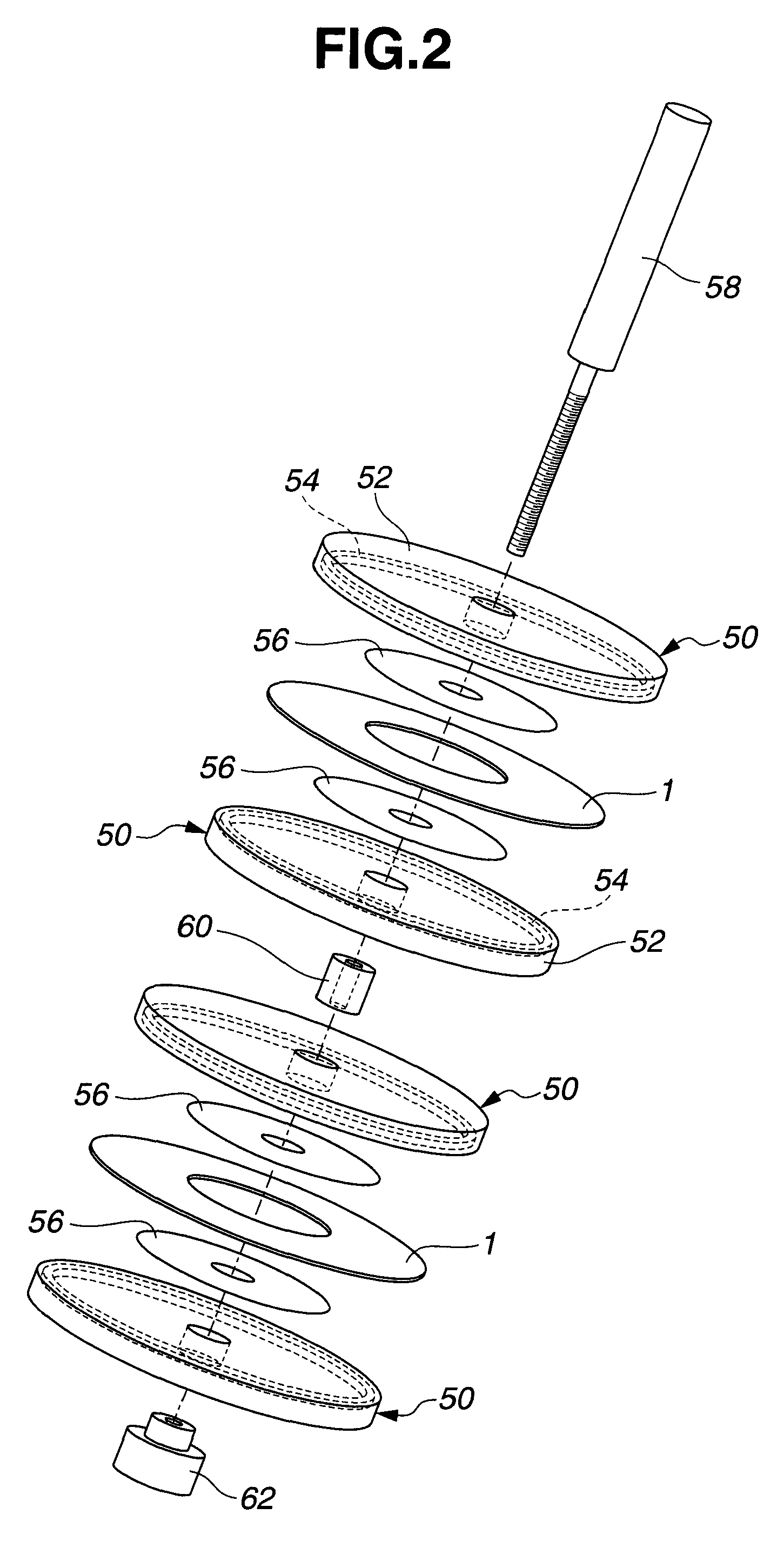Cemented carbide base outer blade cutting wheel and making method
a cutting wheel and cement carbide technology, applied in grinding devices, manufacturing tools, other chemical processes, etc., can solve the problems of shedding and fracture of abrasive grains, heat has a substantial impact on the wear of abrasive grains, and the cutting operation of high-accuracy grains can be substantially saved, and the inspection of cut pieces may be simplified. , the effect of high dimensional accuracy
- Summary
- Abstract
- Description
- Claims
- Application Information
AI Technical Summary
Benefits of technology
Problems solved by technology
Method used
Image
Examples
example 1
[0122]A cemented carbide consisting of 90 wt % WC and 10 wt % Co was machined into an annular thin disc having an outer diameter of 125 mm, an inner diameter of 40 mm, and a thickness of 0.3 mm, which served as a base. The base had a Young's modulus of 600 GPa and a saturation magnetization of 127 kA / m (0.16 T).
[0123]The cemented carbide base was sandwiched between polyphenylene sulfide (PPS) resin discs having an outer diameter of 123 mm and a thickness of 10 mm so that only a circumferential region of either base surface extending 1.0 mm inward from the outer periphery was exposed. The base was immersed in a commercially available aqueous alkaline solution at 40° C. for 10 minutes for degreasing, washed with water, and immersed in an aqueous solution of 30-80 g / L of sodium pyrophosphate at 50° C. where electrolysis was effected at a current density of 2-8 A / dm2. The base was ultrasonic washed in deionized water and immersed in a sulfamic acid Watts nickel plating bath at 50° C. wh...
example 2
[0128]A cemented carbide consisting of 90 wt % WC and 10 wt % Co was machined into an annular thin disc having an outer diameter of 125 mm, an inner diameter of 40 mm, and a thickness of 0.3 mm, which served as a base.
[0129]The cemented carbide base was sandwiched between PPS discs having an outer diameter of 123 mm and a thickness of 10 mm so that only a circumferential region of either base surface extending 1.0 mm inward from the outer periphery was exposed. The base was immersed in a commercially available aqueous alkaline solution at 40° C. for 10 minutes for degreasing, washed with water, and immersed in an aqueous solution of 30-80 g / L of sodium pyrophosphate at 50° C. where electrolysis was effected at a current density of 2-8 A / dm2. The base was ultrasonic washed in deionized water and immersed in a sulfamic acid Watts nickel plating bath at 50° C. where an undercoat was plated at a current density of 5-20 A / dm2. Thereafter, the base was washed with water.
[0130]A ceramic di...
example 3
[0135]A cemented carbide consisting of 90 wt % WC and 10 wt % Co was machined into an annular thin disc having an outer diameter of 125 mm, an inner diameter of 40 mm, and a thickness of 0.3 mm, which served as a base.
[0136]The cemented carbide base was sandwiched between PPS discs having an outer diameter of 123 mm and a thickness of 10 mm so that only a circumferential region of either base surface extending 1.0 mm inward from the outer periphery was exposed. The base was immersed in a commercially available aqueous alkaline solution at 40° C. for 10 minutes for degreasing, washed with water, and immersed in an aqueous solution of 30-80 g / L of sodium pyrophosphate at 50° C. where electrolysis was effected at a current density of 2-8 A / dm2. The base was ultrasonic washed in deionized water and immersed in a sulfamic acid Watts nickel plating bath at 50° C. where an undercoat was plated at a current density of 5-20 A / dm2. Thereafter, the base was washed with water.
[0137]cBN abrasive...
PUM
| Property | Measurement | Unit |
|---|---|---|
| inner diameter | aaaaa | aaaaa |
| inner diameter | aaaaa | aaaaa |
| inner diameter | aaaaa | aaaaa |
Abstract
Description
Claims
Application Information
 Login to View More
Login to View More - R&D
- Intellectual Property
- Life Sciences
- Materials
- Tech Scout
- Unparalleled Data Quality
- Higher Quality Content
- 60% Fewer Hallucinations
Browse by: Latest US Patents, China's latest patents, Technical Efficacy Thesaurus, Application Domain, Technology Topic, Popular Technical Reports.
© 2025 PatSnap. All rights reserved.Legal|Privacy policy|Modern Slavery Act Transparency Statement|Sitemap|About US| Contact US: help@patsnap.com



